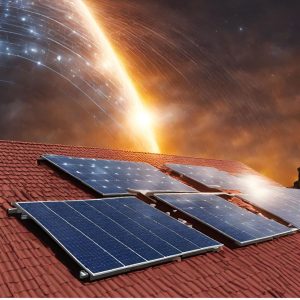Shielding the Sun: Hardening Solar Systems Against Electromagnetic Pulse Attacks

As renewable energy adoption accelerates globally, solar power reigns as an indispensable eco-friendly alternative liberating households from the power grid. But as panels multiply atop rooftops, so too do vulnerabilities surrounding America’s decentralized clean energy movement if left unaddressed.
Specifically, experts warn the weaponization of purposefully triggered high-altitude electromagnetic pulses (EMPs) poses catastrophic risk to vulnerable solar equipment functioning as silent first responders keeping communities operational when disasters or attacks paralyze fragile electric grids.
While such sci-fi wrought scenarios feel fantastical, their origins trace back to 1962’s Starfish Prime tests proving EMP’s widespread debilitating potential, with ripple effects detected 900 miles away in Hawaii. Fast forward fifty years to discover astounding escalations in societies’ electronics dependencies just as EMP generation technologies proliferate globally.
This article spotlights the engineering considerations strengthening solar’s shielding against such threats, ensuring your home energy oasis continues nourishing life-sustaining necessities uninterrupted, regardless of grid integrity loss. Arm yourself with knowledge guaranteeing investments reaping long term dividends as epic storms rage on.
The Anatomy of an EMP
Before exploring solar hardening techniques, first understand what exactly makes EMPs so disruptive. While pop culture frequently depicts EMPs as sudden visible electric eruptions, more accurately they manifest as abrupt sharply peaked surges sending intense electromagnetic emission waves careening at light speed.
Engineered EMP weapons discharge pulses reaching peak intensities within nanoseconds, embedding systems with hundreds of kilovolts per meter or more of electric potential along the way. This momentarily overpowers electrical circuitry ill-equipped regulating such a radical influx. The resulting erratic spike and collapse of voltage soaring then cratering within a fraction of a second essentially fries electronics tripping fail safes temporarily or irreparably.
The duration and intensity of destructive effects depend chiefly on EMPs’ proximity to intended targets. Direct contact with electromagnetic field waves predictably imparts the worst outcomes. Impacts then diminish exponentially the farther surges must travel before striking vulnerable equipment.
This explains why distributed renewal energy infrastructure like wind and rooftop solar prove extremely attractive targets concentrating within communities rather than consolidating inside secured centralized hubs. Their dispersed positioning multiplies exposure risks despite individually smaller generation capacities. Successfully compromising myriad decentralized energy sources collectively amplifies attack consequences burdening entire civil operations and emergency response capabilities.
Shielding Solar Panels and Inverters
When assessing solar system vulnerabilities, begin examining the system’s most accessible and affordable components to harden first – panels and inverters. As photovoltaics soak up rays converting photons into life-sustaining electrons, periods of peak productivity ironically correlate with equipment’s highest exposure risks sitting unobstructed beneath open skies.
Panels containing fragile embedded electronics remain extremely susceptible to transient electromagnetic disturbances. Similar to lightning strikes, sudden power spikes can easily overwhelm regulating capacities causing internal circuit and wiring meltdowns.
Safely shielding panels involves encasing their vulnerability in protective Faraday cages which divert and distribute sudden electromagnetic surges around enclosures rather than directly through sensitive electronics. This sanctuary effect applies across installations including residential scale rooftop arrays, commercial solar canopies shading parking lots, and expansive utility-scale solar farms.
Applying cost-effective Faraday shielding during solar farm construction proves far more affordable than later retrofitting solutions if grid attacks emerge as threats. Check manufacturer warranties ensuring exterior aluminum frame construction and ample internal insulating materials provide adequate buffering of key components to start.
As the gateway between sunlight capture and household use, inverters also require intelligent reinforcement beyond surge-protecting plug strips. While robust grid-tied solar inverters automatically shutdown when detecting grid anomalies, anticipate potential blips entirely by installing inverter-battery combo systems that store sufficient capacity for uninterrupted continuity.
This built-in backup power enables drawing from batteries when sudden solar generation loss occurs, buying time bridging households through transient solar disruptions. For ultimate resilience, make sure inverter/battery systems feature secure military-grade electrical enclosures. EMP protected models undergo extensive spike resilience product testing ensuring household protection persevering long after devastation strikes surrounding neighborhoods.
Supplemental Protection Principles
Beyond addressing solar’s frontline vulnerabilities, introducing redundancies adopting these supplementary principles further strengthens EMP preparations:
● Isolate critical systems into shielded zones away from exterior walls and enclosures. Every inch between disasters and crucial backup equipment enhances protective buffering.
● Install multiple layers of surge protection at central incoming electrical panels guarding entire property grids. Overprotecting beats the alternative.
● Back up digital data onto non-digital formats like printouts stored inside Faraday bagging and physically distant metal filing cabinets. Keep instructions analog.
● Adopt microgrid architectures for neighborhood scale resilience pooling decentralized solar resources with shared community storage banks.
While military sites and critical civil infrastructures prioritize overt EMP countermeasures, private citizens also shoulder responsibility recognizing renewable energy’s pivotal hometown security roles. Invest now in properly equipped solar ensuring households continue thriving long after devastation inevitably strikes as the new gridless frontier dawns.
FAQs
How likely is the US electrical grid to fail from an EMP attack?
While low probability, expert assessments continuously warn our dated, fragile grid poses severe national security vulnerabilities. Multiple reports estimate failure rates exceeding 90% from EMP incidents absent modern protective safeguards.
Would a solar storm from space damage solar equipment similarly to an EMP bomb?
Yes, solar storms and flares eject intense magnetic energy comparable to electromagnetic pulses. These can induce similarly disastrous voltage spikes in unprotected electrical systems and grid infrastructure when impacting Earth.
Can residential solar panels really get damaged by EMPs miles away?
Panels don’t need to endure direct EMP contact given surges propagate through conductive infrastructure. Nearby incidents could induce damaging electrical potential even in building wiring connected downstream. Always prepare for the worst possibilities.
How can I test my solar system’s EMP resilience?
While EMP simulator rentals prove cost prohibitive for consumers, you can confirm inverter/battery performance by temporarily disconnecting solar input. Observe uninterrupted household continuity relying solely on batteries through sunset.
What is the easiest way to shield my existing solar panels from EMPs?
Affordable protective panel coverings like solar blanket Faraday cages effectively buffer solar electronics from electrical surges. Follow manufacturer grounding and installation instructions for optimal effectiveness.
